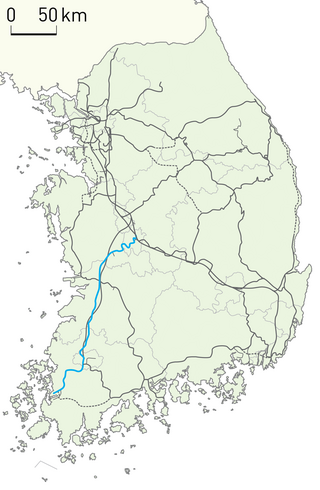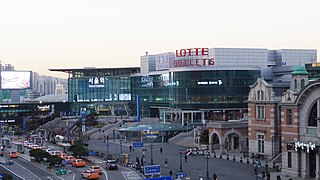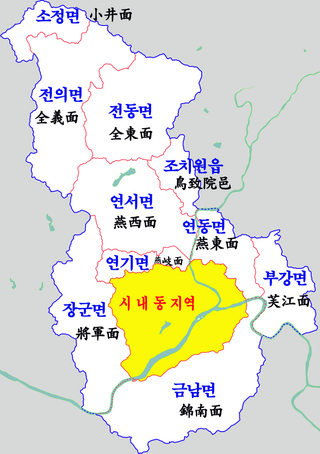
The Gyeongbu line (Gyeongbuseon) is a railway line in South Korea and is considered to be the most important and one of the oldest in the country. It was constructed in 1905, connecting Seoul with Busan via Suwon, Daejeon, and Daegu. It is by far the most heavily travelled rail line in South Korea.

The Honam Line is a major railway line serving the Honam region in South Korea. The line is served by frequent passenger trains from Seoul to Gwangju and Mokpo.

The Chungbuk Line is a railway line serving North Chungcheong Province in South Korea. The line connects Jochiwon on the Gyeongbu Line to Bongyang on the Jungang Line, serving the major cities of Cheongju and Chungju en route. Cheongju International Airport is located near the rail line.

Korea Train eXpress (Korean: 한국고속철도), often known as KTX, is South Korea's high-speed rail system, operated by Korail. Construction began on the high-speed line from Seoul to Busan in 1992. KTX services were launched on April 1, 2004.

Seoul Station (Korean: 서울역) is a major railway station in Seoul, the capital of South Korea. The station is served by the Korail Intercity Lines and the commuter trains of the Seoul Metropolitan Subway.

The Mugunghwa-ho (Korean: 무궁화호) is a class of train operated by Korail, main railway operator of South Korea. Mugunghwa trains are Korail's slowest tier of trains stopping at a number of towns and villages, and operating over a number of lines that are not served by other trains. Journey times are generally twice that of KTX trains and 25% longer than ITX express trains.

Rail transport in South Korea is a part of the transport network in South Korea and an important mode of the conveyance of people and goods, though railways play a secondary role compared to the road network. The network consists of 4,285 km (2,663 mi) of standard-gauge lines connecting all major cities with the exception of Jeju City on Jeju Island, which does not have railways; of the network, 2,790 km (1,730 mi) are double-tracked and 3,187 km (1,980 mi) are electrified. In 2018, rails carried 11.5 percent of all traffic in South Korea – 134.8 million passengers and 30.9 million tonnes of freight – with roads carrying 88.3 percent.

HSR-350x, alternatively called G7, KHST or NG-KTX, is a South Korean experimental high-speed train. It was developed and built in a joint project of government research institutes, universities and private companies that started in 1996, which aimed to reduce import dependence in high-speed rail technology. New components developed for the HSR-350x included motors, electronics, and the carbody of passenger cars. Test runs were conducted between 2002 and 2008. The experimental train achieved the South Korean rail speed record of 352.4 km/h (219.0 mph) in 2004. The HSR-350x was the basis for Korail's KTX-II (KTX-Sancheon) commercial high-speed trains.

Sejong or Sejong City, officially the Sejong Special Self-Governing City, is a special self-governing city and the de facto administrative capital of South Korea.

Cheonan–Asan station is a ground-level train station located mostly in Asan, Chungcheongnam-do, although part of it lies in the neighboring city of Cheonan. This station serves high-speed KTX trains that run from Seoul to either Busan or Mokpo. It is connected to Asan station, a railway station on the Janghang Line which is also served by Line 1 of the Seoul Subway.

The Gyeongbu high-speed railway, also known as Gyeongbu HSR, is South Korea's first high-speed rail line from Seoul to Busan. KTX high-speed trains operate three sections of the line: on 1 April 2004, the first between a junction near Geumcheon-gu Office station, Seoul and a junction at Daejeonjochajang station north of Daejeon, and a second between a junction at Okcheon station, southeast of Daejeon, and a junction near Jicheon station, north of Daegu entered service; then on 1 November 2010, the third section, between a junction west of Daegu and Busan became operational. The missing gaps across the urban areas of Daejeon and Daegu were in construction for an expected opening in 2014, separate tracks into Seoul Station were also planned. The temporary ends of the three sections were connected to the parallel conventional Gyeongbu Line by tracks that will serve as interconnector branches upon the completion of the entire line. On 1 August 2015, construction on urban areas of Daejeon and Daegu were completed; all the sections of HSR line were connected.

The Honam high-speed railway, also known as Honam HSR, is a high-speed rail between Osong and Mokpo in South Korea. The line is a part of Korail's Korea Train Express (KTX) system, accelerating Seoul–Mokpo and Seoul–Gwangju KTX high-speed services which currently use the existing conventional Honam Line. On April 1, 2015, the line was inaugurated by the South Korean President Park Geun-hye with the attendance of 1200 invited guests and members of the public at Gwangju Songjeong Station in Gwangju, the line's terminus. The line diverges from Osong station on the Gyeongbu high-speed railway, and stops at Gongju, Iksan, Jeongeup Stations. Journey times between Seoul and Gwangju has been cut from 2 h 40 min to just 90 min, making daily commuting possible. The Honam HSR is intended to bring business, and economic opportunities to the province of Jeollanam-do, which has seen slower development than other parts of South Korea. The line has been open to the public since April 2, 2015 for revenue service.

Iksan station is on South Korea's high-speed KTX railway network, 243 km south of Yongsan station.

GwangjuSongjeong Station is a station in Gwangju, South Korea. It is on the national high-speed KTX railway network, 341 km south of Yongsan Station.

The KTX-Sancheon is a South Korean high-speed train built by Hyundai Rotem in the second half of the 2000s and operated by Korail since March 2010. With a top speed of 305 km/h (189.5 mph), the KTX-Sancheon is the second commercial high-speed train operated in South Korea and the first domestic high-speed train that is designed and developed in South Korea.

The KTX-I, also known as the TGV-K or Korail Class 100000, is a South Korean high speed train class based on the French TGV Réseau. The 20-car formation of the trainsets without restaurant car is optimized for high capacity. The 46 trainsets were built partly in France and partly in South Korea in the framework of a technology transfer agreement, which was the basis for further domestic high-speed train development in South Korea.

The Super Rapid Train, often known as SRT, is a high-speed rail service operated by SR Corporation. The service starts at Suseo station in southeast Seoul and terminates at either Busan station or Mokpo station.
High-speed rail service in South Korea began with the construction of a high-speed line from Seoul to Busan in 1992, and was inspired by Japan's Shinkansen. The first commercial high-speed rail service was launched on April 1, 2004. Currently, South Korea hosts two high-speed rail operators: Korea Train eXpress (KTX) and Super Rapid Train (SRT).

Jochiwon is a town located in Sejong City, South Korea.

The Suseo–Pyeongtaek high-speed railway, also known as Suseo–Pyeongtaek HSR, is a high-speed rail line from Suseo station in southeast Seoul to a junction with the existing Gyeongbu high-speed railway in South Korea. The line was built to ensure southeast Seoul and southern Gyeonggi-do have high-speed rail connections.

















